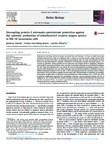Uncoupling protein-2 attenuates palmitoleate protection against the cytotoxic production of mitochondrial reactive oxygen species in INS-1E insulinoma cells
| dc.contributor.author | Barlow, J | |
| dc.contributor.author | Hirschberg Jensen, V | |
| dc.contributor.author | Affourtit, Charles | |
| dc.date.accessioned | 2015-07-09T08:11:20Z | |
| dc.date.available | 2015-07-09T08:11:20Z | |
| dc.date.issued | 2015-04 | |
| dc.identifier.issn | 2213-2317 | |
| dc.identifier.issn | 2213-2317 | |
| dc.identifier.uri | http://hdl.handle.net/10026.1/3417 | |
| dc.description.abstract |
High glucose and fatty acid levels impair pancreatic beta cell function. We have recently shown that palmitate-induced loss of INS-1E insulinoma cells is related to increased reactive oxygen species (ROS) production as both toxic effects are prevented by palmitoleate. Here we show that palmitate-induced ROS are mostly mitochondrial: oxidation of MitoSOX, a mitochondria-targeted superoxide probe, is increased by palmitate, whilst oxidation of the equivalent non-targeted probe is unaffected. Moreover, mitochondrial respiratory inhibition with antimycin A stimulates palmitate-induced MitoSOX oxidation. We also show that palmitate does not change the level of mitochondrial uncoupling protein-2 (UCP2) and that UCP2 knockdown does not affect palmitate-induced MitoSOX oxidation. Palmitoleate does not influence MitoSOX oxidation in INS-1E cells ±UCP2 and largely prevents the palmitate-induced effects. Importantly, UCP2 knockdown amplifies the preventive effect of palmitoleate on palmitate-induced ROS. Consistently, viability effects of palmitate and palmitoleate are similar between cells ±UCP2, but UCP2 knockdown significantly augments the palmitoleate protection against palmitate-induced cell loss at high glucose. We conclude that UCP2 neither mediates palmitate-induced mitochondrial ROS generation and the associated cell loss, nor protects against these deleterious effects. Instead, UCP2 dampens palmitoleate protection against palmitate toxicity. | |
| dc.format.extent | 14-22 | |
| dc.format.medium | Print-Electronic | |
| dc.language | en | |
| dc.language.iso | eng | |
| dc.publisher | Elsevier BV | |
| dc.subject | Pancreatic beta cells | |
| dc.subject | Glucolipotoxicity | |
| dc.subject | Cytoprotection | |
| dc.subject | Mitochondrial dysfunction | |
| dc.subject | Uncoupling protein-2 (UCP2) | |
| dc.subject | Reactive oxygen species | |
| dc.subject | INS-1E insulinoma cells | |
| dc.subject | Non-esterified fatty acids | |
| dc.subject | Obesity | |
| dc.subject | Type 2 diabetes | |
| dc.title | Uncoupling protein-2 attenuates palmitoleate protection against the cytotoxic production of mitochondrial reactive oxygen species in INS-1E insulinoma cells | |
| dc.type | journal-article | |
| dc.type | Journal Article | |
| dc.type | Research Support, Non-U.S. Gov't | |
| plymouth.author-url | https://www.webofscience.com/api/gateway?GWVersion=2&SrcApp=PARTNER_APP&SrcAuth=LinksAMR&KeyUT=WOS:000350813800003&DestLinkType=FullRecord&DestApp=ALL_WOS&UsrCustomerID=11bb513d99f797142bcfeffcc58ea008 | |
| plymouth.volume | 4 | |
| plymouth.publication-status | Published | |
| plymouth.journal | Redox Biology | |
| dc.identifier.doi | 10.1016/j.redox.2014.11.009 | |
| plymouth.organisational-group | /Plymouth | |
| plymouth.organisational-group | /Plymouth/Faculty of Health | |
| plymouth.organisational-group | /Plymouth/Faculty of Health/School of Biomedical Sciences | |
| plymouth.organisational-group | /Plymouth/REF 2021 Researchers by UoA | |
| plymouth.organisational-group | /Plymouth/REF 2021 Researchers by UoA/UoA01 Clinical Medicine | |
| plymouth.organisational-group | /Plymouth/Research Groups | |
| plymouth.organisational-group | /Plymouth/Research Groups/Institute of Translational and Stratified Medicine (ITSMED) | |
| plymouth.organisational-group | /Plymouth/Research Groups/Institute of Translational and Stratified Medicine (ITSMED)/CBR | |
| plymouth.organisational-group | /Plymouth/Users by role | |
| plymouth.organisational-group | /Plymouth/Users by role/Academics | |
| dc.publisher.place | Netherlands | |
| dcterms.dateAccepted | 2014-11-24 | |
| dc.identifier.eissn | 2213-2317 | |
| dc.rights.embargoperiod | No embargo | |
| rioxxterms.versionofrecord | 10.1016/j.redox.2014.11.009 | |
| rioxxterms.licenseref.uri | http://www.rioxx.net/licenses/all-rights-reserved | |
| rioxxterms.licenseref.startdate | 2015 | |
| rioxxterms.type | Journal Article/Review | |
| plymouth.funder | Why do pancreatic beta cells waste energy?::MRC |


